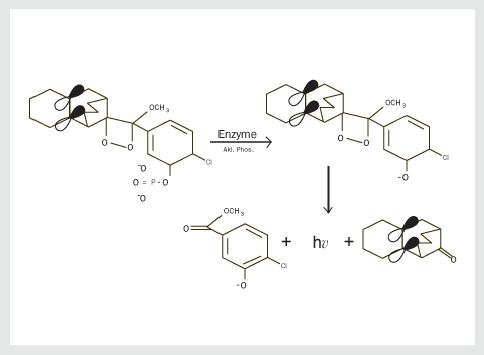| β-Galactosidase Chemiluminescent Substrates | |
|---|---|
| Available Sizes | 250mL |
| 500mL | |
| 100mL | |
| 2L to 100L | |
| Application | |
| Sβ-Gal101 - beta-Galactosidase Substrate in Buffer | beta-Galactosidase enzyme, Reporter gene(lac Z) assays |
| Sβ-Gal102 - beta-Galactosidase Substrate in Buffer Plus | beta-Galactosidase enzyme, Reporter gene(lac Z) assays |
Chemiluminescent Substrate for β-Galactosidase
| DIRECTIONS | |
|---|---|
| 1. | Store the reagent bottle at 2-6oC or -20oC. |
| 2. | Equilibrate the reagent at room temperature till clear solution observed if stored at –20˚C. |
| 3. | Do not contaminate the ß-Galactosidase substrate with ß-Galactosidase enzyme or other proteins. |
| 4. | ß-Galactosidase substrate has a wide range to detect ß-Galactosidase enzyme in solution as well as on membrane. The lower enzyme concentration may be attograms and the highest concentration ß-Galactosidase enzyme may be nanogram depending on the source of the ß-Galactosidase enzyme. |
| 5. | To obtained good results, wash the tube or microtiter plate or membrane with 0.1M phosphate buffer, pH 7.2 to 7.4, and then use the substrate. |
| 6. | Best results for chemiluminescence detection of ß-Galactosidase enzyme or reporter assays can be obtained from 30 minutes to 45 minutes incubation of ß-Galactosidase substrate with ß-Galactosidase enzyme and read the plate or tube within 2 to 10 minutes after triggering the reaction mixture by accelerator or enhancer. |
Detection of ß-Galoctosidase in Microtiter Plate Luminometer
| 1. | Add 5 to 10ml of diluted ß-Galactosidase enzyme or cell extract to microplate wells. |
| 2. | Add 50 to 100ml of ß-Galactosidase substrate and incubate for 30 to 60 minutes at room temperature. |
| 3. | Add 50 to 100ml of triggering reagent and shake it for 10sec. |
| 4. | Place the microtiter plate in luminometer and start reading. |
| 5. | Best results are obtained between 2 to 10 minutes. |
| 6. | Control No.: IMDPvt.Ltd-04, Rev. 0 |
Chemiluminescent Substrates for ß- Galactosidase Enzyme
ß-D-Galactosidase galactohydrolase or ß-Galactosidase enzyme has been detected in numerous microorganisms, animals and plants. In some E. coli strains about 5% of the total protein content is ß-Galactosidase if lactose is the sole source of carbon. Its large size makes it less suitable for EIH but is one of the most commonly used enzymes for reporter gene assays. Reporter gene assays are invaluable in the studies of gene regulatory elements. The gene that encodes ß-Galactosidase (lac Z) is a commonly used reporter gene in molecular biology.
Our new series of ultra-sensitive 1, 2-dioxetanes can detect -Galactosidase enzyme at very low level. MDPvt.Ltdchemiluminescent system is at least 100 times more sensitive compared to the best competitor. These novel 1, 2-dioxetanes are protected by US Patent 6,461,876B1and other pending PCT and US patent applications. The kinetic results of low level of ß-Galactosidase enzyme and Giri Diagnostic, Pvt.Ltd(MDPvt.Ltd) substrate can be shown as:
MDPvt.Ltdsubstrates for ß-Galactosidase enzyme are more sensitive due to the effect of p-electrons on the decomposition of 1, 2-dioxetanes intermediate in the form of phenoxide ion formed after the interaction of galactoside group on 1, 2-dioxetane and ß-Galactosidase enzyme and can be shown as:

MDPvt.Ltdoffers a number of kits and substrates that are designed specifically to detect lacZ expression in cells transformed with the lacZ gene. Our line of chemiluminescent ß-Galactosidase substrates includes galactoside derivatives of several different 1, 2-dioxetanes.
